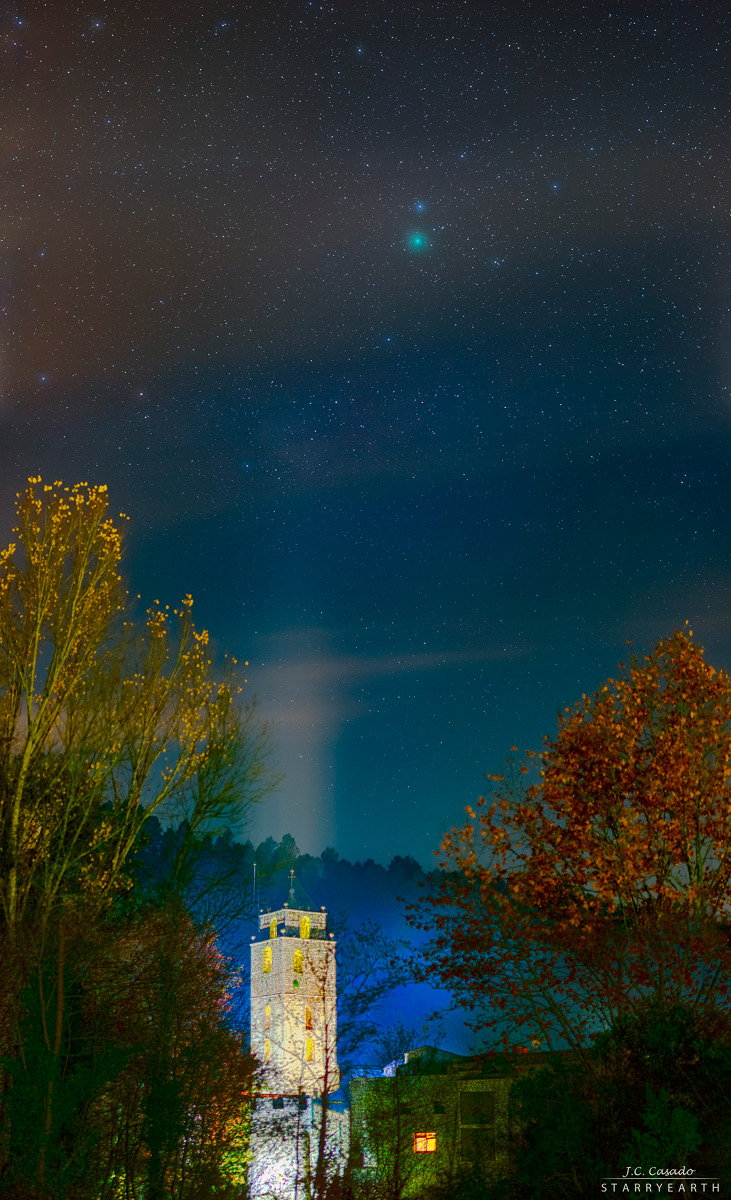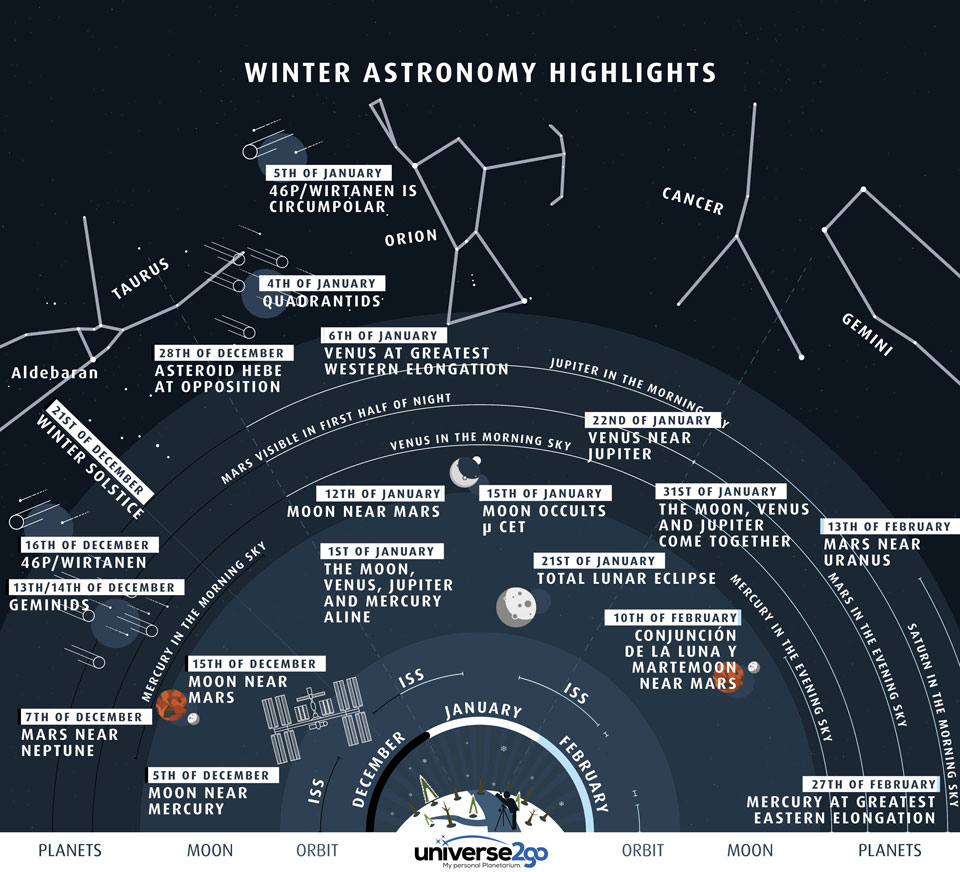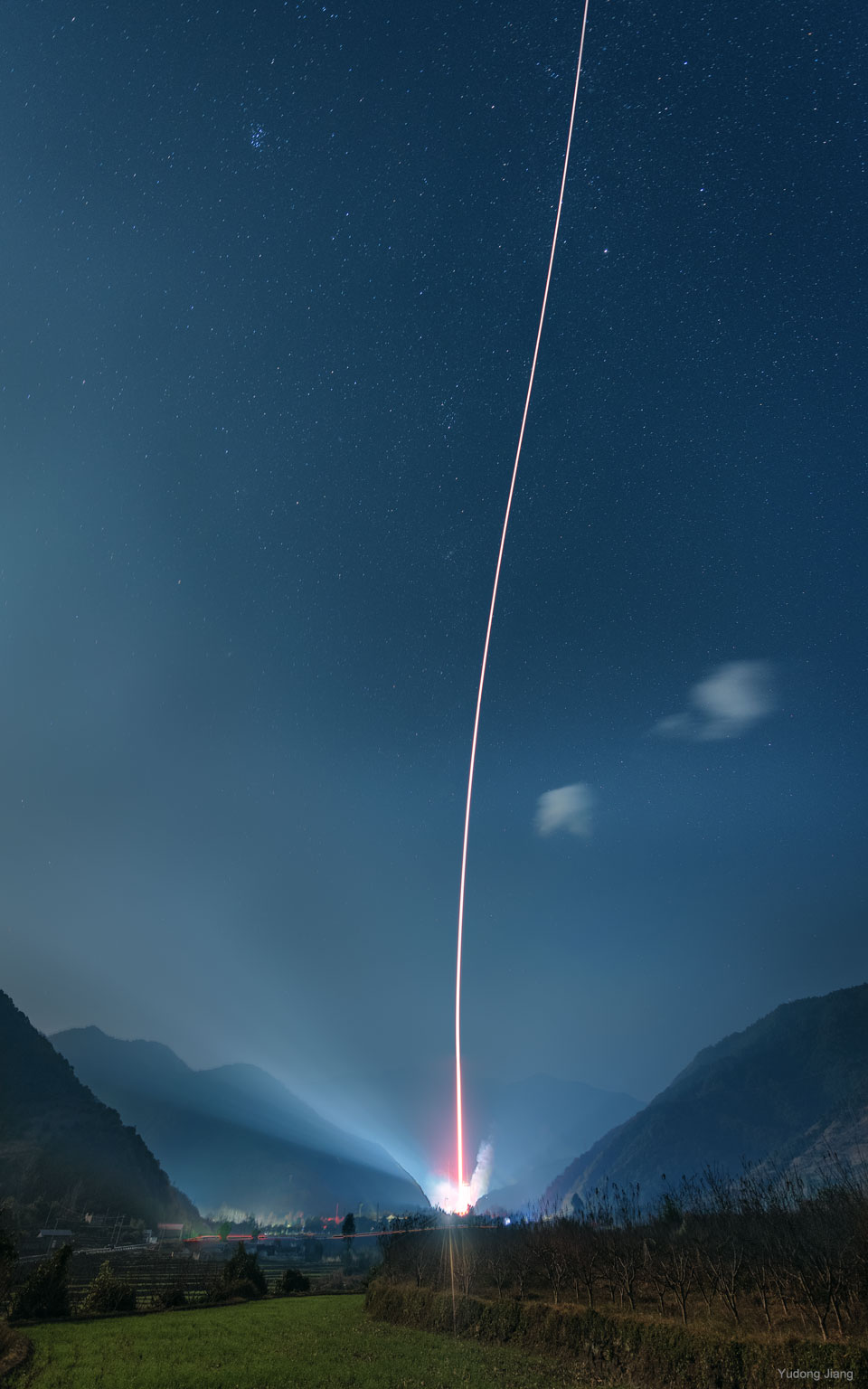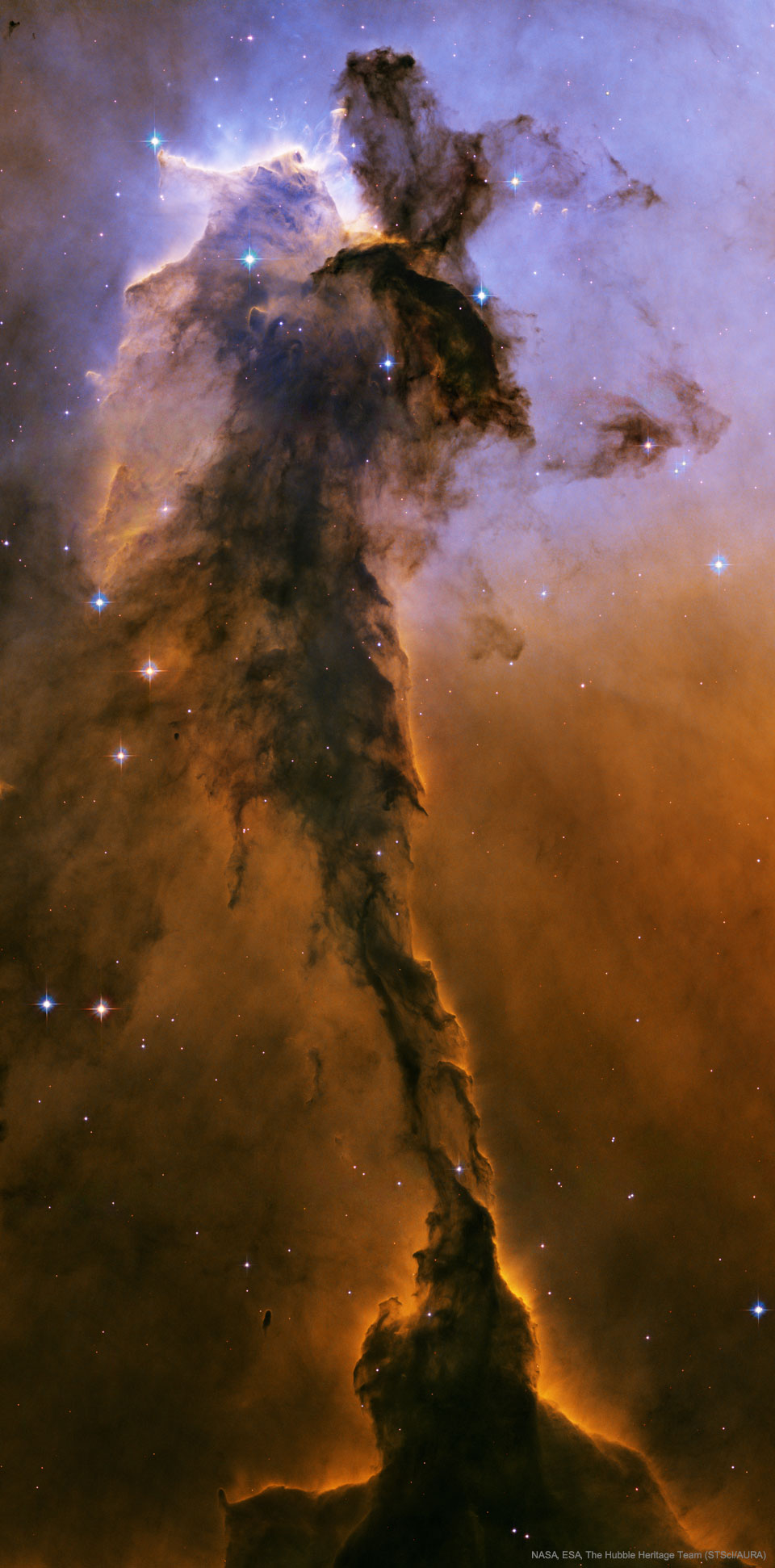Explanation: You can pack a lot of sky watching into 30 seconds on this tiny planet. Of course, the full spherical image timelapse video was recorded on planet Earth, from Grande Pines Observatory outside Pinehurst, North Carolina. It was shot in early September with a single camera and circular fisheye lens, digitally combining one 24-hour period with camera and lens pointed up with one taken with camera and lens pointed down. The resulting image data is processed and projected onto a flat frame centered on the nadir, the point directly below the camera. Watch as clouds pass, shadows creep, and the sky cycles from day to night when stars swirl around the horizon. Keep watching, though. In a second sequence the projected center is the south celestial pole, planet Earth's axis of rotation below the tiny planet horizon. Holding the stars fixed, the horizon itself rotates as the tiny planet swings around the frame, hiding half the sky through day and night.
Nombre total de pages vues
08/12/2018
Tiny Planet Timelapse - Astronomy picture of the day - 2018 December 8
07/12/2018
December's Comet Wirtanen - Astronomy picture of the day - 2018 December 7

Image Credit & Copyright: Juan Carlos Casado (TWAN, Earth and Stars)
Explanation: Coming close in mid-December, Comet 46P Wirtanen hangs in this starry sky over the bell tower of a Romanesque church. In the constructed vertical panorama, a series of digital exposures capture its greenish coma on December 3 from Sant Llorenc de la Muga, Girona, Catalonia, Spain, planet Earth. With an orbital period that is now about 5.4 years, the periodic comet's perihelion, its closest approach, to the Sun will be on December 12. On December 16 it will be closest to Earth, passing at a distance of about 11.6 million kilometers or 39 light-seconds. That's close for a comet, a mere 30 times the Earth-Moon distance. A good binocular target for comet watchers, Wirtanen could be visible to the unaided eye from a dark sky site. To spot it after dusk on December 16, look close on the sky to the Pleiades star cluster in Taurus.
05/12/2018
Highlights of the North Winter Sky - Astronomy picture of the day - 2018 December 5

Image Credit & Copyright: Universe2go.com
Explanation: What can you see in the night sky this season? The featured graphic gives a few highlights for Earth's northern hemisphere. Viewed as a clock face centered at the bottom, early (northern) winter sky events fan out toward the left, while late winter events are projected toward the right. Objects relatively close to Earth are illustrated, in general, as nearer to the cartoon figure with the telescope at the bottom center -- although almost everything pictured can be seen without a telescope. As happens during any season, constellations appear the same year to year, and, as usual, the Geminids meteor shower will peak in mid-December. Also as usual, the International Space Station (ISS) can be seen, at times, as a bright spot drifting across the sky after sunset. Less usual, the Moon is expected to pass nearly in front of several planets in early January. A treat this winter is Comet 46P/Wirtanen, already bright, will pass only 36 lunar distances from the Earth in mid-December, potentially making it easily visible to the unaided eye.
04/12/2018
Rocket Launch between Mountains - Astronomy picture of the day - 2018 December 4

Explanation: What's happening between those mountains? A rocket is being launched to space. Specifically, a Long March 3B Carrier Rocket was launched from Xichang Satellite Launch Center in Sichuan Province in China about two week ago. The rocket lifted two navigation satellites to about 2,000 kilometers above the Earth's surface, well above the orbit of the International Space Station, but well below the orbit of geostationary satellites. China's Chang'e 3 mission that landed the robotic Yutu rover on the Moon was launched from Xichang in 2013. The featured image was taken about 10 kilometers from the launch site and is actually a composite of nine exposures, including a separate background image.
03/12/2018
Spiraling Supermassive Black Holes - Astronomy picture of the day - 2018 December 3
Video Credit: NASA's Goddard Space Flight Center; Music: In the Hall of the Mountain King by Edvard Grieg
Explanation: Do black holes glow when they collide? When merging, co-orbiting black holes are sure to emit a burst of unusual gravitational radiation, but will they emit light, well before that, if they are surrounded by gas? To help find out, astrophysicists created a sophisticated computer simulation. The simulation and featured resulting video accurately depicts two spiraling supermassive black holes, including the effects of Einstein's general relativity on the surrounding gas and light. The video first shows the system from the top, and later from the side where unusual gravitational lens distortions are more prominent. Numerical results indicate that gravitational and magnetic forces should energize the gas to emit high-energy light from the ultraviolet to the X-ray. The emission of such light may enable humanity to detect and study supermassive black hole pairs well before they spiral together.
The Fairy of Eagle Nebula - Astronomy picture of the day - 2018 December 2

Explanation: The dust sculptures of the Eagle Nebula are evaporating. As powerful starlight whittles away these cool cosmic mountains, the statuesque pillars that remain might be imagined as mythical beasts. Featured here is one ofseveral striking dust pillars of the Eagle Nebula that might be described as a gigantic alien fairy. This fairy, however, is ten light years tall and spews radiation much hotter than common fire. The greater Eagle Nebula, M16, is actually a giant evaporating shell of gas and dust inside of which is a growing cavity filled with a spectacular stellar nursery currently forming an open cluster of stars. This great pillar, which is about 7,000 light years away, will likely evaporate away in about 100,000 years. The featured image in scientifically re-assigned colors was released in 2005 as part of the fifteenth anniversary celebration of the launch of the Hubble Space Telescope.
Nobel salue une révolution contre le cancer - Santé/Médecine
 |
Des traitements d'immunothérapie sont déjà sur le marché, et de nombreux essais cliniques confirment le potentiel de ces molécules contre différents cancers avancés difficiles à traiter.
afp.com/PASCAL PAVANI
|
Le prix Nobel de médecine 2018 a récompensé une découverte qui révolutionne aujourd'hui la prise en charge du cancer : l'immunothérapie. Chacun de leur côté, l'Américain James P. Allison, et le Japonais Tasuku Honjo ont mis à jour des molécules permettant de lever les freins de notre système immunitaire, pour qu'il puisse s'attaquer aux cellules cancéreuses. "Cela a permis d'établir un tout nouveau principe pour soigner le cancer", a souligné l'Assemblée Nobel de l'Institut Karolinska à Stockholm. Explications.
James P. Allison a développé un anticorps monoclonal capable de venir bloquer l'action d'une molécule appelée CTLA-4 présente à la surface des lymphocyte T, et qui agit comme un frein. Il a été le premier à montrer chez des souris, dans un article paru dans Science en 1996, qu'un tel médicament pouvait entraîner une diminution, et dans certains cas une disparition complète, des tumeurs et de leurs métastases. Tasuku Honjo, lui, a découvert un autre "frein" du système immunitaire, PD1, et a développé une molécule pour bloquer ce frein. "C'est un paradigme révolutionnaire : on vient aider les patients à soigner leur cancer avec leurs propre globules blancs", résume le Dr Aurélien Marabelle, de Gustave-Roussy, un des centres français aujourd'hui les plus en pointe dans l'utilisation et les recherches sur l'immunothérapie.
L'Express - Sciences - France
01/12/2018
Mount Everest Star Trails - Astronomy picture of the day - 2018 December 1

Image Credit & Copyright: Jeff Dai (TWAN)
Explanation: The highest peak on planet Earth is framed in this mountain and night skyscape. On September 30, the digital stack of 240 sequential exposures made with a camera fixed to a tripod at an Everest Base Camp captured the sheer north face of the Himalayan mountain and foreground illuminated by bright moonlight. Taken over 1.5 hours, the sequence also recorded colorful star trails. Reflecting the planet's daily rotation on its axis, their motion is along gentle concentric arcs centered on the south celestial pole, a point well below the rugged horizon. The color of the trails actually indicates the temperatures of the stars. Blueish hues are from hotter stars, and yellow to reddish hues are from stars cooler than the Sun.
Magnésio e fibromialgia - Saude/Medecina

A Fibromialgia é uma síndrome que se caracteriza principalmente pela existência de dores generalizadas, cansaço extremo e perturbações no sono. Normalmente existe também a presença conjunta de vários outros sintomas que podem variar.
O magnésio é muito importante para a função do músculo, do sistema imunológico, do humor e da produção de energia, os quais tendem a ser prejudicados nos casos de fibromialgia. Não é surpreendente que muitas pessoas com fibromialgia beneficiem com o uso do magnésio.
Segundo o reumatologista do CREB – Centro de Reumatologia e Ortopedia Botafogo, Sérgio Rosenfeld, – o magnésio é responsável pela queima do açúcar e por reações que dão origem a compostos energéticos. “Os portadores de fibromialgia em geral apresentam deficiência de magnésio, mineral que ajuda no relaxamento dos músculos. A reposição desse mineral tem sido utilizada em muitos estados dolorosos, especialmente em cefaléias, com bons resultados. O magnésio também pode ajudar no sono e em espasmos ou cãibras”, explica o Dr. Sérgio.
O Magnésio ativa o enzima mais importante no corpo, ATP (trifosfato de adenosina) uma molécula de energia produzida dentro de um componente das células, chamada mitocondria, “forno” da energia do corpo. Cerca de 20 por cento da produção de ATP está localizada no cérebro. Como resultado, os níveis diminuídos podem reduzir as funções cognitivas do cérebro, um problema comum em pessoas com fibromialgia.
30/11/2018
Cancer du sein : une radiothérapie en 1 minute au lieu de 6 semaines, une première ! - Santé/Médecine
 Grande première : une machine conçue par un médecin français a permis de soigner une patiente atteint de cancer du sein en seulement 1 minute de radiothérapie, au lieu de 6 semaines.
Grande première : une machine conçue par un médecin français a permis de soigner une patiente atteint de cancer du sein en seulement 1 minute de radiothérapie, au lieu de 6 semaines.
Remplacer 6 semaines de radiothérapie par… 40 secondes d'irradiation, c'est maintenant possible pour certaines patientes atteintes de cancer du sein. Réalisée pendant l'opération permettant d'ôter la tumeur, cette courte irradiation est rendue possible par un nouvel appareil, le Papillon +, conçu par le Pr Jean-Pierre Gérard, Radiothérapeute au Centre Antoine Lacassagne (Nice). En cours d'essai, il pourrait bientôt traiter 10% des malades, spécifiquement les plus âgées avec de petites tumeurs.
Lire l'article dans son intégralité sur
Sciences et Avenir
Inscription à :
Commentaires (Atom)
LES BELLES I?VENTIONS DE LEONARD DE VINCI - La vis d'Archimède et l'ingénierie hydraulique
Léonard de Vinci était passionné par l'ingénierie hydraulique et par les travaux d' Archimède . On voit donc ici une vis d'Arc...

-
2022 September 26 All the Water on Planet Earth Illustration Credit: Jack Cook, Adam Nieman, Woods Hole Oceanographic Institution ; Data ...
-
2025 May 11 The Surface of Venus from Venera 14 Image Credit: Soviet Planetary Exploration Program , Venera 14 ; Processing & Copyri...